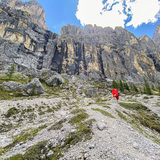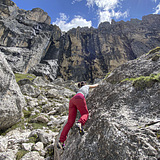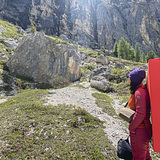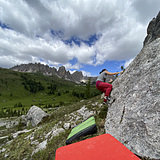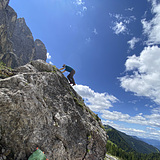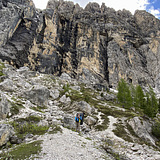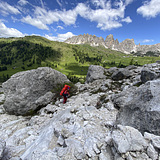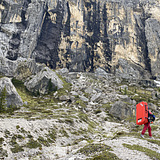Chi sente pronunciare "Dolomiti" pensa solitamente ad alte pareti con vie classiche, ma anche il bouldering dice la sua!
Il Passo Gardena collega due delle valli dolomitiche più belle in assoluto, la Val Gardena e la Val Badia. Chi ha percorso questa strada almeno una volta conosce esattamente la sensazione che regalano le ripide pareti delle Meisules ⛰quando ci si passa sotto in macchina.
L'area bouldering si trova a 2000 metri ed è tra una delle più famose aree di arrampicata dell'Alto Adige, la falesia Frea, con i suoi oltre cento tiri di corda. Nei mesi di Luglio e Agosto possono essere fastidiosi i rumori del traffico della strada del passo, ma l'atmosfera e l’ambiente montano sono fantastici, soprattutto verso sera quando il pendio è ricoperto di luce arancione. I massi sono ben visibili dalla strada e sotto le grandi pareti, ci sono passaggi su strapiombo, verticale e placca su buchi e tacche svase.
😬Atterraggio
Solitamente buono (crash pad comunque obbligatori!), ma a volte può essere ripido e quindi consigliato almeno un paratore.
🪨Tipo di Roccia
Dolomia, esposizione Nord-Ovest
⚠️ si consiglia di controllare sempre le condizioni della roccia, appigli, ecc., vista la lunga presenza di neve in inverno
☀️Clima
E’ possibile arrampicare nel periodo estivo da giugno a settembre. Essendo ad alta quota in assenza di neve e temperature non rigide. Dopo lunghe piogge i massi si asciugano rapidamente.
------
🇬🇧
Those who hear "Dolomites" usually think of high walls with classic routes, but bouldering also has a say!
Passo Gardena connects two of the most beautiful valleys in the Dolomites, Val Gardena and Val Badia. Anyone who has traveled this road at least once knows exactly how the steep walls of the Meisules give ⛰when you drive under it.
The bouldering area is located at 2000 meters and is among one of the most famous climbing areas in South Tyrol, the Frea crag, with its over one hundred pitches of rope. In the months of July and August the traffic noises of the pass road can be annoying, but the atmosphere and the mountain environment are fantastic, especially in the evening when the slope is covered with orange light. The boulders are clearly visible from the road and under the large walls, there are passages on the overhang, vertical and slab on holes and flared notches.
😬Landing
Usually good (crash pads mandatory anyway!), But can sometimes be steep and therefore at least one paratore is recommended.
🪨Type of Rock
Dolomia, North-West exposure
⚠️ it is advisable to always check the conditions of the rock, holds, etc., given the long presence of snow in winter
☀️Climate
It is possible to climb in the summer from June to September. Being at high altitude in the absence of snow and non-rigid temperatures. After long rains, the boulders dry quickly.
